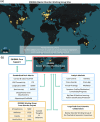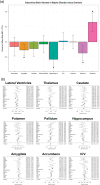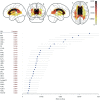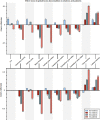What we learn about bipolar disorder from large-scale neuroimaging: Findings and future directions from the ENIGMA Bipolar Disorder Working Group
- PMID: 32725849
- PMCID: PMC8675426
- DOI: 10.1002/hbm.25098
What we learn about bipolar disorder from large-scale neuroimaging: Findings and future directions from the ENIGMA Bipolar Disorder Working Group
Abstract
MRI-derived brain measures offer a link between genes, the environment and behavior and have been widely studied in bipolar disorder (BD). However, many neuroimaging studies of BD have been underpowered, leading to varied results and uncertainty regarding effects. The Enhancing Neuro Imaging Genetics through Meta-Analysis (ENIGMA) Bipolar Disorder Working Group was formed in 2012 to empower discoveries, generate consensus findings and inform future hypothesis-driven studies of BD. Through this effort, over 150 researchers from 20 countries and 55 institutions pool data and resources to produce the largest neuroimaging studies of BD ever conducted. The ENIGMA Bipolar Disorder Working Group applies standardized processing and analysis techniques to empower large-scale meta- and mega-analyses of multimodal brain MRI and improve the replicability of studies relating brain variation to clinical and genetic data. Initial BD Working Group studies reveal widespread patterns of lower cortical thickness, subcortical volume and disrupted white matter integrity associated with BD. Findings also include mapping brain alterations of common medications like lithium, symptom patterns and clinical risk profiles and have provided further insights into the pathophysiological mechanisms of BD. Here we discuss key findings from the BD working group, its ongoing projects and future directions for large-scale, collaborative studies of mental illness.
Keywords: ENIGMA; MRI; bipolar disorder; cortical surface area; cortical thickness; mega-analysis; meta-analysis; neuroimaging; psychiatry; volume.
© 2020 The Authors. Human Brain Mapping published by Wiley Periodicals LLC.
Conflict of interest statement
O. A. A. received Speaker's honorarium from Lundbeck and is a consultant for HealthLytix. M. B. was supported by an unrestricted grant from AstraZeneca. A. C. B. is a full‐time employee of P1vital Ltd. C. R. K. C. and P. M. T. have received partial research support from Biogen, Inc. (Boston, USA) for work unrelated to the topic of this manuscript. T. E. has received a speaker's fee from Lundbeck. G. M. G. is a NIHR Emeritus Senior Investigator, holds shares in P1vital and P1Vital products and has served as consultant, advisor or C. M. E. speaker in the last 3 years for Allergan, Angelini, Compass pathways, MSD, Janssen, Lundbeck (/Otsuka or /Takeda), Medscape, Minerva, P1Vital, Pfizer, Sage, Servier, Shire, Sun Pharma. D. P. H. is a full‐time employee of Genentech, Inc. A. M. M. has received research support from the Eli Lilly, Janssen and The Sackler Trust. J. C. S. has participated in research funded by Forest, Merck, BMS, and GSK and has been a speaker for Pfizer and Abbott. Marsal Sanches has received research grants from Janssen. All other authors from this site report no conflicts of interest to declare. D. J. S. has received research grants and/or consultancy honoraria from Lundbeck and Sun. E. V. has received grants and served as consultant, advisor or CME speaker for the following entities (work unrelated to the topic of this manuscript): AB‐Biotics, Abbott, Allergan, Angelini, Dainippon Sumitomo Pharma, Galenica, Janssen, Lundbeck, Novartis, Otsuka, Sage, Sanofi‐Aventis, and Takeda.
Figures









References
-
- Abramovic, L. , Boks, M. P. , Vreeker, A. , Bouter, D. C. , Kruiper, C. , Verkooijen, S. , … van Haren, N. E. (2016). The association of antipsychotic medication and lithium with brain measures in patients with bipolar disorder. European Neuropsychopharmacology, 26(11), 1741–1751. 10.1016/j.euroneuro.2016.09.371 - DOI - PubMed
-
- Altimus, C. (2019) Supporting wellness: A survey of lived experience. [PDF file]. Retrieved from: http://milkeninstitute.org/sites/default/files/reports-pdf/Supporting%20...
Publication types
MeSH terms
Grants and funding
- T32 MH073526/MH/NIMH NIH HHS/United States
- MR/S035818/1/MRC_/Medical Research Council/United Kingdom
- UL1 TR001863/TR/NCATS NIH HHS/United States
- T32 AG058507/AG/NIA NIH HHS/United States
- U54 EB020403/EB/NIBIB NIH HHS/United States
- R21 MH113871/MH/NIMH NIH HHS/United States
- R37 MH100041/MH/NIMH NIH HHS/United States
- K23 MH085096/MH/NIMH NIH HHS/United States
- MC_PC_17209/MRC_/Medical Research Council/United Kingdom
- MR/L010305/1/MRC_/Medical Research Council/United Kingdom
- R01 MH080912/MH/NIMH NIH HHS/United States
- K23 MH074644/MH/NIMH NIH HHS/United States
- R01 MH100041/MH/NIMH NIH HHS/United States
- P20 GM121312/GM/NIGMS NIH HHS/United States
- R01 MH096957/MH/NIMH NIH HHS/United States
- 104036/Z/14/Z/WT_/Wellcome Trust/United Kingdom
- R01 MH060952/MH/NIMH NIH HHS/United States
- R01 MH083968/MH/NIMH NIH HHS/United States
- K23 MH098130/MH/NIMH NIH HHS/United States
- R01 MH059929/MH/NIMH NIH HHS/United States
- R01 MH095454/MH/NIMH NIH HHS/United States
- DH_/Department of Health/United Kingdom
- K08 MH086786/MH/NIMH NIH HHS/United States
- R01 MH116147/MH/NIMH NIH HHS/United States
- R01 MH101111/MH/NIMH NIH HHS/United States
- R01 MH106324/MH/NIMH NIH HHS/United States
- R56 AG058854/AG/NIA NIH HHS/United States
- R01 MH075007/MH/NIMH NIH HHS/United States
- WT_/Wellcome Trust/United Kingdom
- 216767/Z/19/Z/WT_/Wellcome Trust/United Kingdom
- R03 MH105808/MH/NIMH NIH HHS/United States
- R01 MH107703/MH/NIMH NIH HHS/United States
- R01 MH085667/MH/NIMH NIH HHS/United States
- R01 MH090553/MH/NIMH NIH HHS/United States
- R01 MH076971/MH/NIMH NIH HHS/United States
LinkOut - more resources
Full Text Sources
Medical
Miscellaneous

